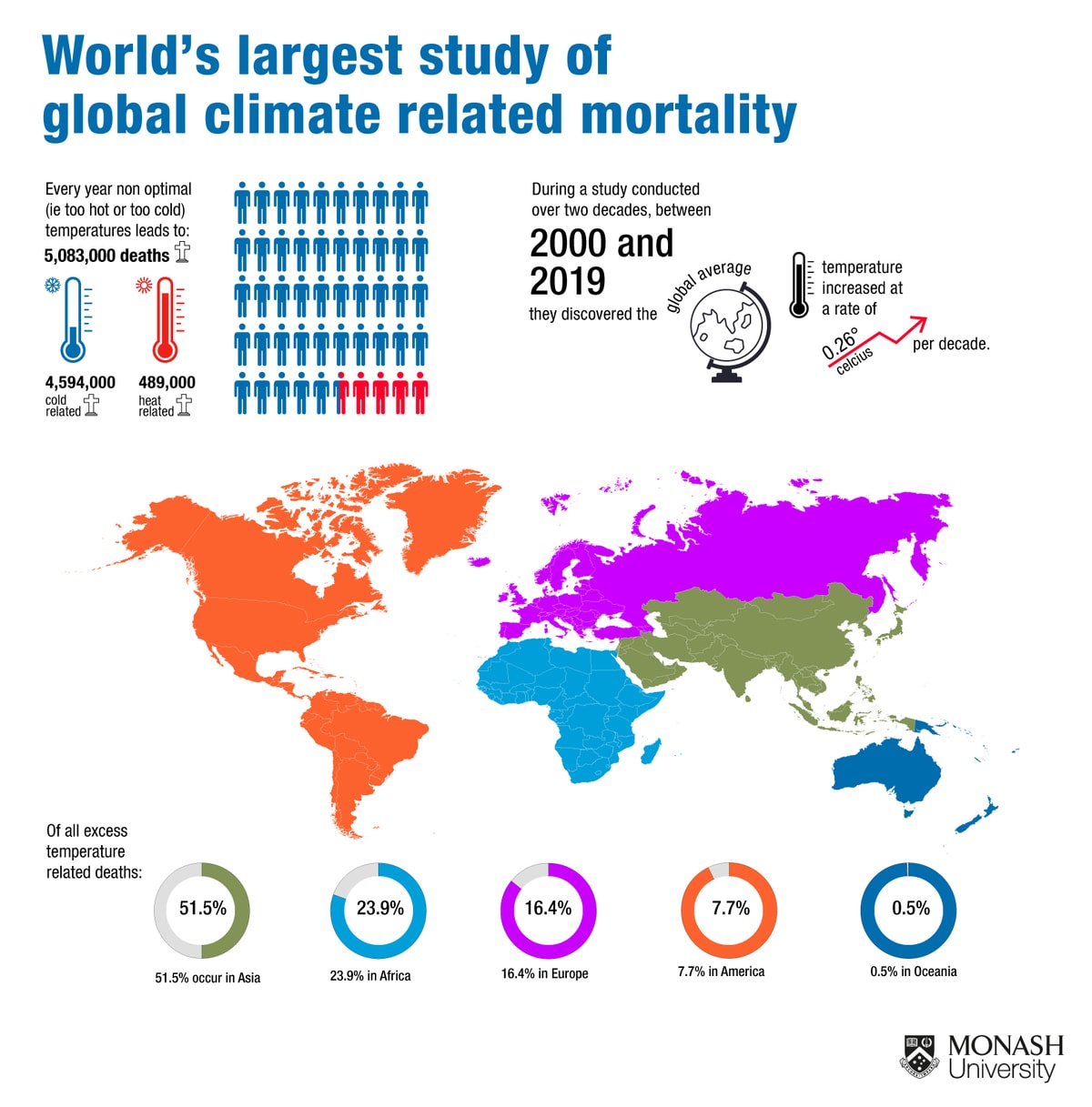Everybody knows the weather affects our health, but until now, it's not been possible to precisely measure its impact.
-
Yuming Guo
Professor, Global Environmental Health and Biostatistics; Head, Monash Climate, Air Quality Research (CARE) Unit
Now, an international team of researchers, led by environmental epidemiologists Professor Yuming Guo and Dr Shanshan Li, has found that more than five million extra deaths a year can be attributed to hot and cold temperatures.
Their study examined temperature-related mortality rates between 2000 and 2019, "the hottest period since the pre-Industrial era", Professor Guo says.
"Importantly, we used 43 countries' baseline data across five continents with different climates, socioeconomic and demographic conditions, and differing levels of infrastructure and public health services," he says.
Professor Guo, who's from the Monash School of Public Health and Preventive Medicine, says most previous studies had looked at temperature-related mortality within a single country or region only, and so were not able to accurately assess the impact of climate on a global scale.
"Climate change is a very serious problem across the world. It is a global issue, an emergency. It's been recognised as our most challenging environmental problem. But it will also affect the health of human communities," he says.

Deaths across 19 years
The researchers counted the number of temperature-related deaths over 19 years, and charted how that changes as global temperatures rose.
The closest comparable international study, the Global Burden of Disease (GBD) 2020, has estimated the extent of temperature-related mortality to be about three million deaths per year. But that estimate was based on data from fewer than 100 cities, and was an underestimate, Professor Guo says.
His team's research, which has been published in The Lancet Planetary Health, examined data from 750 cities around the world "to establish the relationship between temperature and the mortality of each city".
The researchers took into account a range of factors, including air temperature, the region's temperature range, and its GDP.
The large and diverse data sets collected by the researchers were then used to predict how daily temperature could affect mortality rates within a 50 × 50-square-kilometre area, which the study called a "grid".
"In the long-term, climate change is expected to increase the mortality burden, because heat-related mortality will continue to increase."
In this way they built a global picture of how changes in temperature affected mortality rates over the course of a year.
They found that inhabitants in poorer regions were more susceptible to changes in temperature, because people were less able to protect themselves from the elements, and fewer people had access to cooling and heating, he says. But in more affluent places, heatwaves and cold snaps were also a matter of life and death.
An area's temperature range was important, too, because populations acclimatise to local conditions. The study found that the highest rate of heat-related deaths was in Eastern Europe, for example, where the winters are generally harsh, while the highest rates of cold-related deaths were found in two hot zones: South Asia and sub-Saharan Africa.
Deaths likely to rise
As hot days become more intense and frequent, the number of deaths caused by hot weather is likely to rise, Professor Guo says.
That's already happening in Australia, for instance, but at the same time, the number of cold-related deaths is falling in this country. As a consequence, the net number of temperature-related deaths in Australia has fallen for the time being.
The same paradoxical results can be seen on a larger scale. Southeast Asia saw the largest decline in net temperature-related mortality over the 19 years' study period, with the largest increases in South Asia and Europe.
Professor Guo stresses that "in the long-term, climate change is expected to increase the mortality burden, because heat-related mortality will continue to increase".
In parallel, "cold-related mortality should be less … the heat-related mortality won't be offset by the cold-related".
The large data sets collected by his team are now being used as the basis for future projections - from 2020 to 2100 - on temperature-related deaths for the Intergovernmental Panel on Climate Change (IPCC). The scientific reports published by the IPCC help inform international agreements to limit greenhouse gases.
Professor Guo says understanding the geographic patterns of temperature-related mortality "is important for the international collaboration in developing policies and strategies in climate change mitigation and adaptation, and health protection".






